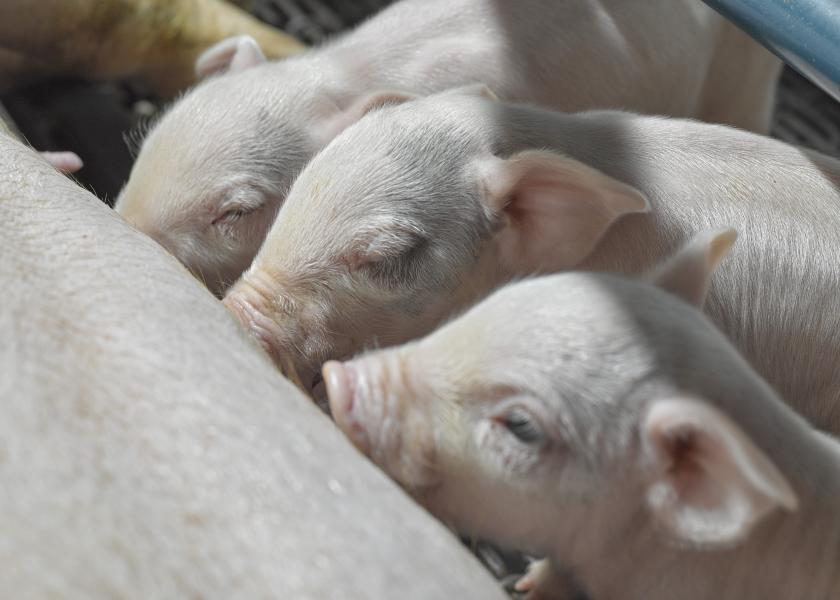Robustness Impacts Overall Profitability

By JoAnn Alumbaugh
The term “robustness” means different things to different people, but producers know it’s an important component in raising pigs.
The trait has been described as “a central concept in reconciling productivity and feed efficiency with health, adaptation, welfare and reproduction” (Phocas et al. 2014). In pig breeding, robust pigs were defined by Knap (2005) “as pigs that combine high production potential with resilience to external stressors, allowing for unproblematic expression of high production potential in a wide variety of environmental conditions.”
Knap provided examples of robustness traits including pre-weaning survival of piglets and rebreeding success of sows. Additional robustness traits may extend to include survival of growing pigs, disease incidence and possibly maternal genetic components that improve growth and health status of growing pigs.
William Herring, Ph.D., PIC director of genetic development, sees robustness as the ability of the pig, through genetic improvement, to grow and convert feed, to become a full-value market hog with a low potential for mortality, and to wean many high-quality piglets in the face of normal disease challenges. Robustness is the ability of the pig to be resilient in the face of those conditions, and then extends through finishing in the form of efficient gain in challenged conditions, he says.
From a genetic improvement perspective, Herring puts robustness into three categories: gilt and sow soundness, pre-weaned piglets, and wean-to-finish pigs.
1. Sow soundness
“If you look at one of the primary causes of fallout, and ultimately sow mortality, lameness is one of those causes near the top of the list, regardless of the system,” Herring says.
Factors contributing to lameness may include genetics (heredity), bacterial infections, environment and nutrition, wrote Craig Rowles, DVM, in diagnostic notes for the American Association of Swine Veterinarians.
“Osteochondrosis and degenerative joint disease (DJD) are common causes of lameness,” Rowles said. “These diseases are associated with slippery floors, lack of exercise and rapid growth rate, and cause lameness in animals less than 2 years of age.”
Genetic suppliers are working to minimize lameness as a hereditary effect.
“When we weigh, scan and evaluate underlines, we also score both future parent boars and gilts for front and back leg soundness,” Herring notes. “We have supportive historical data, and we also have on-going field trials in large production settings, in which we score animals and track them all the way through to later parities to be sure that our leg scoring system remains effective.”
Such factors contribute to pigs weaned per sow per year (PSY), he notes, and other traits like milk production and high quality underlines are critical.
2. Pre-weaned piglets
Birth weight, liveability and growth rate are key in getting pigs off to a good start at birth.
“We look at the ability of the pig to make it to weaning and have a heavy weaning weight,” Herring explains. “We weigh every individual piglet of our maternal lines at birth, because we know that a higher birth weight sets the table for that piglet’s life.” These pigs grow faster and are more robust post-weaning, giving them a greater probability of becoming a full-value market pig. Weaning weight and milk production also are important measurables.
PIC included pre-weaning livability into its breeding objective for all maternal lines in 2013. “We still want large litters but we also want larger piglets on average at birth,” Herring says. “Without that, you have the unintended consequence of driving litter size up but farrowing lighter piglets at birth…and we’ve seen positive responses in actual production.”
3. Wean-to-finish pigs
Pigs that don’t grow fast or can’t remain healthy from wean to finish represent a huge cost to producers. Herring says the company directly tackles the trait of wean-to-finish livability with unique data captured from its genetic nucleus (GN) crossbred program, which began 15 to 20 years ago.
“We’re able to trace each pig back to its respective sire and dam, and this creates a data flow that is meaningful for use in genetic improvement at the elite nucleus sites where the same genes exist,” Herring says.
The welfare component
In addition to the direct traits related to livability described above, robustness carries an important animal welfare element. Producers have a responsibility to ensure animals thrive in their environment, that they’re well-cared for, and that they’re in good health, says Dan Hamilton, Ph.D., PIC director of product validation and technical services.
“We definitely want to put animal welfare first and foremost,” he says. “Additionally, it’s a huge economic cost to the producer [if an animal fails to thrive].”
The cost associated with producing, maintaining and housing an animal is significant, so every animal must be productive to meet cost demands.
“Anytime you have a mortality or [morbidity], additional treatments may be needed, so robustness is a big economic driver as well.
“And don’t forget worker morale,” Hamilton adds. “A robust animal is an animal that is doing well. Workers definitely care about their animals so that’s positive all the way around.”
Continual improvement
Pig breeding programs around the world continue to improve both productivity and robustness by extending selection emphasis to a wider range of traits, say the authors of “Selection for productivity and robustness traits in pigs,” (S. Hermesch, L. Li, A. Doeschl-Wilson and H. Gilbert).
“No trait group can be seen in isolation. Further, genetic improvement itself cannot be viewed in isolation and needs to be accompanied by improvement in management strategies,” they said, siting the following four strategies. Click here to see the strategies on page 2.








